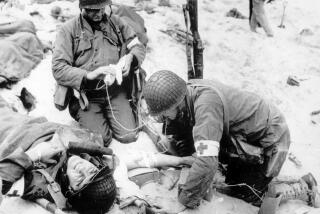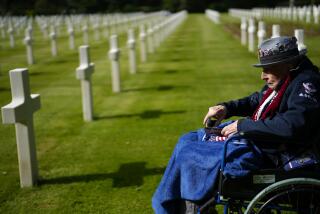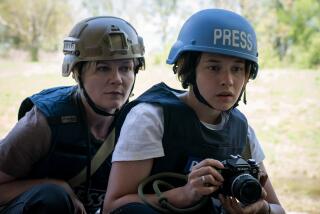Wearing Medals and Bearing Memories
WASHINGTON â Sometimes itâs her face, little changed after six decades in its primary features, the dark eyes and slightly crooked smile of an adventurer. Sometimes itâs the pallet of ribbons and medals on her dress uniform.
And every now and then, itâs the gold flight-nurse pin -- the original one, in Art Deco -- that tips people off.
âHey, I know you,â said Lt. Col. Don Smith, an Air Force historian who noticed the old pin. âI wrote a paper on you.â
âOh,â said Lillian Kinkella Keil. âWonderful!â
One of the most decorated women in U.S. military history, the longtime Covina resident was among the tens of thousands of World War II veterans who gathered on the National Mall on Saturday to dedicate a memorial of their own.
In the shadow of the Washington Monument, with the Lincoln Memorial shimmering in the distance and cicadas clattering in the breeze, they shared stories of sacrifice and heroism, sometimes aloud with other survivors, sometimes silently with the dead.
A white-haired man with a shrapnel-scarred face leaned on his cane and cried during a procession of flags. Keil knelt beside the wheelchair of Glenn Bartlett and whispered about the Battle of Bastogne, where Bartlett was wounded by the Nazis.
âWe all waited a long time for it,â Keil said of the monument. âItâs the most beautiful thing.â
Keilâs story, sheâs the first to say, was but one among many Saturday, a tale largely of good fortune that includes a long life in spite of two wars. But her story, as admirers noted, is one worth telling.
The diminutive, black-haired Keil, who always demurs when asked her age, saying, âIâm a lady,â flew 250 combat evacuation missions during World War II as an in-flight nurse, and an additional 175 during the Korean War. By rough calculation, the retired Army Air Forces captain tended to more than 10,000 wounded soldiers, sailors and Marines in the air, often while her plane was being rocked by antiaircraft fire, punctured by flak. She wears 16 ribbons and medals, marked by 11 different battle stars.
Keil seldom discusses the dangerous routes she traveled for others, though, or even the lives she saved.
âMost of them were unconscious or on anesthesia or morphine,â she said, âso they donât remember me.â
The stories she tells tend to be about the limbs she couldnât sew back on, the warmth she could not provide patients in the bitterly cold belly of a C-47 cargo plane, the wounded she could never tend to.
âIt was snowing, snow thick on the ground. This was at Thionville, France,â not long after D-day in mid-1944, she recalled. âThere were 12 litters in the snow, 12 men. But we couldnât land. We could see them and they could see us. Some of them were waving, âHere we are! Here we are!â But we couldnât land. We had to leave them there in the snow.â
In 1938, Keil was working as a registered nurse when her mother suggested a route to adventure: Take her medical skills to the sky and become a stewardess. Keil had never heard the word âstewardessâ or even seen an airplane up close. Within weeks of visiting United Airlinesâ base in Oakland, however, she became one of the carrierâs first âstews.â
The early days of commercial aviation were pure romance. Keil recalls serving coffee, tea or milk to the likes of Eleanor Roosevelt, Charles Lindbergh and Cary Grant.
In 1943, with World War II raging from Europe to the Pacific, Keil wrote a letter to the War Department, and was soon headed to the Army Air Forcesâ Air Evacuation School at Bowman Field near Louisville, Ky. She was going to be a flight nurse.
She learned how to survive in the desert, in the cold, how to escape an airplane that had to ditch at sea. One exercise had her swimming through a burning oil slick, another firing Colt .45 pistols and M1 Garand rifles.
And then she shipped out to Britain, and the desperate fight to turn back Hitlerâs charge across Europe.
On D-day, her crew went into Normandy behind glider planes, clumsy, powerless transports whose pilots, if they made it through the flak, often crashed among the trees and hedgerows of France.
On Saturday, as a giant television screen on the Mall flashed pictures of men dying in the surf on Utah Beach and U.S. bombers folding in on themselves and plummeting through the sky, Keil pulled from her purse a small black-and-white photograph she had taken.
It was of the inside of one of her C-47s, and the carnage from Normandy. One patientâs arms were covered with bandages. âBurns,â Keil said.
Anotherâs wounds were unclear. âProbably spinal injury. Thereâs not another litter on top of him. Thatâs how we did it when it was a spinal injury.â Another manâs leg ended at the knee, the stump wrapped in gauze. âWeâd wrap it real tight like that so they wouldnât know theyâd lost their leg.â
Had the planes served only to evacuate casualties, Keil and the other crew members might have enjoyed the minor comfort that came with a red cross painted on their tails or fuselages. But these were warplanes too. When they lifted off in Britain, they were loaded with hundreds of jerrycans of gasoline, 101-millimeter artillery shells, drums of oil to supply Gen. George Pattonâs forces. When they returned, they were loaded with the wounded and the dead.
âTwenty-four men,â Keil said. And they seldom returned with less than a full load.
Keil was in London when the first buzz bombs came in. She was there for D-day and the Battle of the Bulge.
Many pilots were sent home after 50 missions; Keil flew five times that number.
In 1946, a year after the war ended, Keil returned to United Airlines and became a stewardess again. Four years later, the war in Korea broke out and she signed up for more duty, notifying United only afterward.
She evacuated the wounded during the landing at Inchon, the fighting at Chosin Reservoir.
On Saturday, she walked through the crowds still tending, in a way, to the wounded.
âHello. How are you? Iâm Lillian,â she said, kneeling beside the wheelchair of yet another stranger, 97-year-old Ed White of Rhinebeck, N.Y., who was captured by the Nazis in France in December 1944.
A short time later a man approached and said simply, âIâd like to shake your hand.â They shook and he left.
After Korea, Keil went home, got married, had two daughters and became a homemaker. In 1953, Republic Pictures made a movie based on her life, âFlight Nurse.â In 1961, she was the subject of one of the most-watched episodes of âThis Is Your Life.â
Thatâs not why people want to meet her, though, or why a few seem to remember her.
Every now and again, someone who once found himself cold and bleeding inside the belly of an airplane, the morphine perhaps wearing off, looking for a hand to hold, recognizes those dark eyes, that smile.
Earlier in the week, at a discussion about D-day leading up to Saturdayâs dedication, a man approached Keil. His name was Norman.
âI remember you. You treated me.â
More to Read
Sign up for Essential California
The most important California stories and recommendations in your inbox every morning.
You may occasionally receive promotional content from the Los Angeles Times.










